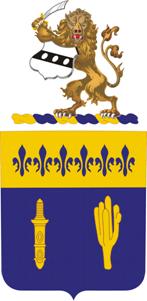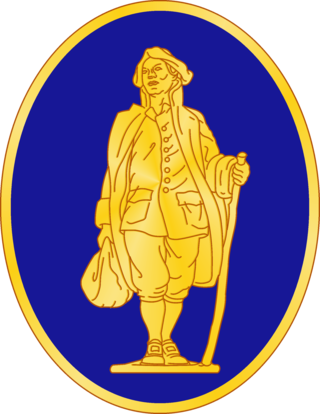
Wendell P. Bowman (October 31, 1847 – April 8, 1928) was a major general in the Pennsylvania National Guard, and served as commander of the 28th Infantry Division.

Wendell P. Bowman (October 31, 1847 – April 8, 1928) was a major general in the Pennsylvania National Guard, and served as commander of the 28th Infantry Division.
Wendell Phillips Bowman was born in Byberry, Pennsylvania on October 31, 1847. He lived at his family's home, "Cream Ridge," and was educated at the Benjamin Rush School and the Byberry Friends' School.
He was still a boy when the American Civil War broke out in 1861, and was too young for military service, so he became a drummer for a militia unit, the Byberry Guards.
At age 15 he joined the 44th Pennsylvania Militia, which was later mustered into federal service as a unit of the Pennsylvania Reserves. He was a participant in the 1863 Battle of Gettysburg, and was discharged later in 1863.
In July, 1864 Bowman joined the 197th Pennsylvania Infantry, and he served until November.
He then joined an Iowa regiment, in which he served until being discharged for ill health. Bowman was unable to walk as a result of his illness and complications caused by the harsh conditions of his service, and used crutches until he was able to begin walking unaided again in 1874.
After the war Bowman studied law in the firm of George H. Earle, Sr. and Richard P. White (brother and husband of Caroline Earle White), attained admission to the bar, and practiced in Philadelphia.
Bowman was active in the Grand Army of the Republic, and served as Judge Advocate of the Department of Pennsylvania. He was also a sought after speech maker, and gave orations for Pennsylvania's Republican Party, Decoration Day commemorations, and other celebrations.
On April 18, 1876 Bowman married Elizabeth (Lizzie) W. Malcolm (died October 26, 1929), the daughter of Baptist clergyman Thomas Shields Malcolm.
In 1877 Bowman joined the 20th Pennsylvania Regiment, which was organized to respond to labor unrest during the Great Railroad Strike of 1877.
In 1878 he received a commission as a captain in command of Company H, 1st Regiment, Pennsylvania National Guard. He advanced through the ranks and became regimental commander with the rank of colonel in 1887.
Bowman volunteered for the Spanish–American War and his regiment was mustered into federal service in 1898. He was seriously injured during training at Mount Gretna on May 2, 1898, and was unable to lead the regiment when it departed Pennsylvania, so command passed to his lieutenant colonel, J. Lewis Good.
The war ended before the 1st Pennsylvania departed for Cuba. Bowman resumed command after the regiment returned to Pennsylvania from its encampment in Tennessee.
In 1907 Bowman became commander of Pennsylvania's 1st Brigade as a brigadier general.
In 1909 he became commander of the Pennsylvania National Guard Division, the organization later known as the 28th Infantry Division, and was promoted to major general. He served until retiring in 1910, and was succeeded by Charles B. Dougherty.
Bowman died at his home "The Elms" in Merion Station, Pennsylvania on April 8, 1928, and was buried at Merion Friends Burial Ground. [1]

The Army National Guard (ARNG) is an organized militia force and a federal military reserve force of the United States Army. It is simultaneously part of two different organizations: the Militia of the United States, as well as the federal ARNG, as part of the National Guard as a whole. It is divided into subordinate units stationed in each state or insular area, responsible to their respective governors or other head-of-government.

The 28th Infantry Division ("Keystone") is a unit of the United States Army National Guard, and is the oldest division-sized unit in the Army. Some of the units of the division can trace their lineage to Benjamin Franklin's battalion, The Pennsylvania Associators (1747–1777). The division was officially established in 1879 and was later redesignated as the 28th Division in 1917, after the entry of America into the First World War. It is today part of the Pennsylvania Army National Guard, Maryland Army National Guard, Ohio Army National Guard, and New Jersey Army National Guard.

The Pennsylvania National Guard is one of the oldest and largest National Guards in the United States Department of Defense. It traces its roots to 1747 when Benjamin Franklin established the Associators in Philadelphia.

The New York Army National Guard is a component of the New York National Guard and the Army National Guard. Nationwide, the Army National Guard comprises approximately one half of the United States Army's available combat forces and approximately one third of its support organization. National coordination of various state National Guard units are maintained through the National Guard Bureau.

The Pennsylvania Army National Guard, abbreviated PAARNG, is part of the United States Army National Guard and is based in the U.S. Commonwealth of Pennsylvania. Together with the Pennsylvania Air National Guard, it is directed by the Pennsylvania Department of Military and Veterans Affairs. The PAARNG maintains 124 armories and is present in 87 communities across the Commonwealth.

The 112th Infantry Regiment, also known as the Sixteenth Pennsylvania, is a unit in the Pennsylvania National Guard which can trace its lineage back to before the American Civil War.

The 164th Regiment (Regional Training Institute) is a training unit of the North Dakota Army National Guard. As the 164th Infantry Regiment, it was formed during World War I, but traces its history to Dakota Territorial Militia units formed in the 1880s. The regiment was the first United States Army unit to land on Guadalcanal during World War II.

Daniel Bursk Strickler was the 19th lieutenant governor of Pennsylvania from 1947 to 1950, under Governor James Duff. He was also a career officer in the United States Army, with service on active duty, in the Army Reserve, and in the Pennsylvania Army National Guard, and he served as commander of the 28th Infantry Division.

The 109th Infantry Regiment is a parent infantry regiment of the United States Army, represented in the Pennsylvania Army National Guard by the 1st Battalion, 109th Infantry, part of the 2nd Brigade Combat Team, 28th Infantry Division.

The 111th Infantry Regiment, originally the Pennsylvania Militia or "Associators", were a Pennsylvania militia unit that fought in the American Revolution, composed of civilian males from the citizenry of Pennsylvania. It is one of several National Guard units with colonial roots and campaign credit for the War of 1812. The Pennsylvania Militia often fought in conjunction with General Washington and the Continental Army along the Delaware River.

The 56th Stryker Brigade Combat Team (SBCT), 28th Infantry Division, also known as the Independence Brigade, is a brigade combat team of the Pennsylvania Army National Guard and has its headquarters located at Horsham Air Guard Station in Willow Grove, Pennsylvania.
The 213th Air Defense Artillery is a regiment in the Pennsylvania Army National Guard.

George C. Rickards was a United States Army major general who served as Chief of the Militia Bureau, the first National Guard officer to hold this position.

The 107th Field Artillery Regiment is a Field Artillery Branch regiment of the United States Army. It has been affiliated with the Pennsylvania National Guard since its formation. It appears that the regiment last formally came into existence in June 1959, when the 107th Field Artillery Battalion was reorganized as the new Regiment's 1st Battalion in line with the Pentomic (ROCID) reorganization going on at that time.

Charles Maxwell Clement was a Pennsylvania attorney and Army National Guard officer who attained the rank of major general as commander of the 28th Infantry Division.

John A. Wiley was a Pennsylvania business executive, Civil War veteran, and National Guard officer who attained the rank of major general as commander of the organization now known as the 28th Infantry Division.

The 4th Pennsylvania Infantry Regiment, officially known as the 4th Regiment, Pennsylvania Volunteer Infantry, was an infantry regiment of the Union Army in the American Civil War. Formed mostly from a militia unit in Norristown in southeastern Pennsylvania, the regiment enlisted at the beginning of the American Civil War in April 1861 for a three-month period of service under the command of Colonel John F. Hartranft. Logistical difficulties bedeviled the regiment, which served as part of the garrison of Washington, D.C., until late June, when it was sent into Northern Virginia to join in the army of Brigadier General Irvin McDowell.

Charles Bowman Dougherty was an officer in the Pennsylvania Army National Guard. He attained the rank of major general as commander of the 28th Infantry Division.

The 21st Pennsylvania Volunteer Infantry was a three-month infantry regiment that served in the Union Army during the American Civil War.